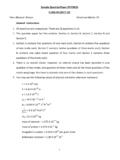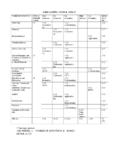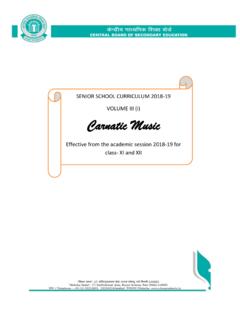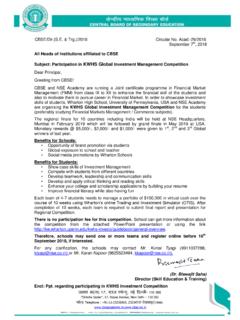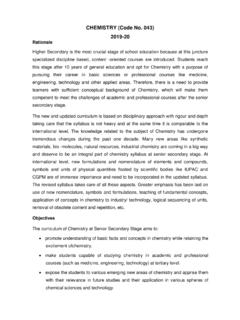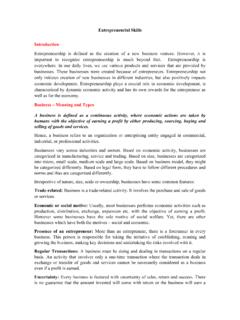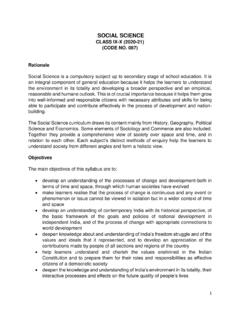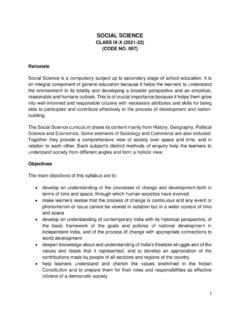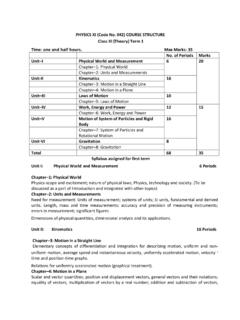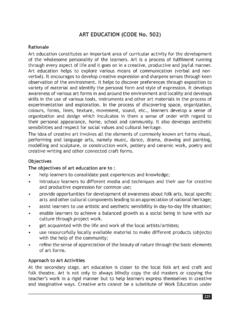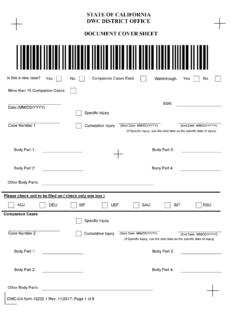Transcription of BIOLOGY (Code No. 044) 2021-22
1 1 BIOLOGY (Code No. 044) 2021-22 The present curriculum provides the students with updated concepts along with an extended exposure to contemporary areas of the subject. The curriculum also aims at emphasizing the underlying principles that are common to animals, plants and microorganisms as well as highlighting the relationship of BIOLOGY with other areas of knowledge. The format of the curriculum allows a simple, clear, sequential flow of concepts. It relates the study of BIOLOGY to real life through the use of technology. It links the discoveries and innovations in BIOLOGY to everyday life such as environment, industry, health and agriculture.
2 The updated curriculum focuses on understanding and application of scientific principles, while ensuring that ample opportunities and scope for learning and appreciating basic concepts continue to be available within its framework. The broad aims of the curriculum are: promote understanding of basic principles of BIOLOGY encourage learning of emerging knowledge and its relevance to individual and society promote rational/scientific attitude especially towards issues related to population, environment and development enhance awareness about environmental issues, problems and their appropriate solutions create awareness amongst the learners about diversity in living organisms and develop respect for other living beings appreciate that the most complex biological phenomena are built on essentially simple processes develop skills that are relevant to the study and practice of BIOLOGY encourage a systematic approach to problem solving encourage effective communication It is expected that the students would get an exposure to various branches of BIOLOGY in the curriculum in a more contextual and systematic manner as they
3 Study its various units. BIOLOGY (Code No. 044) COURSE STRUCTURE CLASS XI ( 2021-22 ) (THEORY) Time: 03 Hours Max. Marks: 70 Unit Title No. of Periods Marks I Diversity of Living Organisms 27 12 II Structural Organization in Plants and Animals 27 12 III Cell: Structure and Functions 26 12 IV Plant Physiology 40 17 V Human Physiology 40 17 Total 160 70 2 Unit-I Diversity of Living Organisms Chapter-1: The Living World What is living? Biodiversity; Need for classification; taxonomy and systematics; concept of species and taxonomical hierarchy; binomial nomenclature; tools for study of taxonomy- museums, zoological parks, herbaria, botanical gardens, keys for identification.
4 Chapter-2: Biological Classification Five kingdom classification; Salient features and classification of Monera, Protista and Fungi into major groups; Lichens, Viruses and Viroids. Chapter-3: Plant Kingdom Salient features and classification of plants into major groups - Algae, Bryophyta, Pteridophyta, Gymnospermae and Angiospermae (salient and distinguishing features and a few examples of each category): Angiosperms - classification up to class, characteristic features and examples. Plant life cycles and alternation of generations Chapter-4: Animal Kingdom Basis of Classification; Salient features and classification of animals, non-chordates up to phyla level and chordates up to class level (salient features and distinguishing features of a few examples of each category).
5 (No live animals or specimen should be displayed in school.) Unit-II Structural Organization in Plants and Animals Chapter-5: Morphology of Flowering Plants Morphology and modifications: Morphology of different parts of flowering plants: root, stem, leaf, inflorescence, flower, fruit and seed. Description of families: Fabaceae, Solanaceae and Liliaceae (to be dealt along with the relevant experiments of the Practical Syllabus). Chapter-6: Anatomy of Flowering Plants Anatomy and functions of different tissues and tissue systems in dicots and monocots. Secondary growth. Chapter-7: Structural Organisation in Animals Animal tissues; Morphology, Anatomy and functions of different systems ( digestive , circulatory, respiratory, nervous and reproductive) of an insect-cockroach (a brief account only).
6 Unit-III Cell: Structure and Functions Chapter-8: Cell-The Unit of Life Cell theory and cell as the basic unit of life, structure of prokaryotic and eukaryotic cells; Plant cell and animal cell; cell envelope; cell membrane, cell wall; cell organelles - structure and function; endomembrane system - endoplasmic reticulum, ribosomes, golgi bodies, lysosomes, vacuoles; mitochondria, plastids, microbodies; cytoskeleton, cilia, flagella, centrioles (ultrastructure and function); nucleus. 3 Chapter-9: Biomolecules Chemical constituents of living cells: biomolecules, structure and function of proteins, carbohydrates, lipids, nucleic acids; concept of metabolism; Enzymes - properties, enzyme action, factors, classification, Co-factors.
7 Chapter-10: Cell Cycle and Cell Division Cell cycle, mitosis, meiosis and their significance Unit-IV Plant Physiology Chapter-11: Transport in Plants Movement of water, gases and nutrients; cell to cell transport - diffusion, facilitated diffusion, active transport; plant-water relations, imbibition, water potential, osmosis, plasmolysis; long distance transport of water - Absorption, apoplast, symplast, transpiration pull, root pressure and guttation; transpiration, opening and closing of stomata; Uptake and translocation of mineral nutrients - Transport of food, phloem transport, mass flow hypothesis.
8 Chapter-12: Mineral Nutrition Elementary idea of hydroponics as a method to study mineral nutrition; essential minerals, macro- and micronutrients and their role; deficiency symptoms; mineral toxicity; nitrogen metabolism, nitrogen cycle, biological nitrogen fixation. Chapter-13: Photosynthesis in Higher Plants Photosynthesis as a means of autotrophic nutrition; early experiments, site of photosynthesis, pigments involved in photosynthesis (elementary idea); photochemical and biosynthetic phases of photosynthesis; cyclic and non-cyclic photophosphorylation; chemiosmotic hypothesis; photorespiration; C3 and C4 pathways; factors affecting photosynthesis.
9 Chapter-14: Cellular Respiration Exchange of gases; do plants breathe; cellular respiration - glycolysis, fermentation (anaerobic), TCA cycle and electron transport system (aerobic); energy relations - number of ATP molecules generated; amphibolic pathways; respiratory quotient. Chapter-15: Plant - Growth and Development Seed germination; characteristics, measurements and phases of plant growth, growth rate; conditions for growth; differentiation, dedifferentiation and redifferentiation; sequence of developmental processes in a plant cell; growth regulators - auxin, gibberellin, cytokinin, ethylene, ABA; seed dormancy; vernalisation; photoperiodism.
10 Unit-V Human Physiology Chapter-16: Digestion and Absorption Alimentary canal and digestive glands, role of digestive enzymes and gastrointestinal hormones; Peristalsis, digestion, absorption and assimilation of proteins, carbohydrates and fats; egestion; nutritional and digestive disorders - indigestion, constipation, vomiting, jaundice, diarrhoea. Chapter-17: Breathing and Exchange of Gases Introduction to respiratory organs in animals; Respiratory system in humans; mechanism of breathing and its regulation in humans - exchange of gases, transport of gases and regulation of respiration, respiratory volumes; disorders related to respiration - asthma, emphysema, occupational respiratory disorders.
